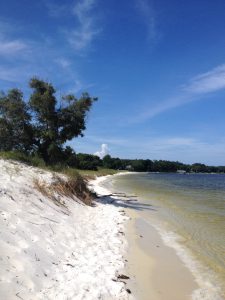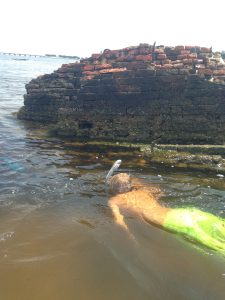
Pensacola Bay has long been a sailor’s dream—a deep water port with easy access to the Gulf of Mexico. It was literally put on the map for this reason, and from the 17th to 19th centuries, was an international hub for shipping local products like snapper and timber.
Like many port towns during this shipping heyday, our area struggled with preventing illness from uncurable (at the time) diseases like yellow fever, smallpox, and malaria. To prevent spread of diseases, it was standard practice worldwide to quarantine any ship entering the bay. Most ships were expected to spend two weeks docked at a quarantine station before sailors could enter the community. If anyone developed an illness in that timeframe, a makeshift hospital at the quarantine station provided treatment if possible. If individuals succumbed to their illnesses, they were buried on the spot.

Locally, our primary quarantine station was the appropriately named “Deadman’s Island.” Located along the north side of Gulf Breeze near the mouth of Navy Cove, this peninsula was safely inside the bay but a few miles from the population center in Pensacola. Hundreds of years ago, it was a substantial piece of land with mature vegetation and plenty of space. Now, however, the area is relatively small (10 acres) with just enough space to pull up a small boat and walk around. There is a wetland area and some dune vegetation, and the City of Gulf Breeze has spearheaded significant efforts to preserve the swiftly eroding island using reefs and living shorelines. Due to its historical significance, shipwrecks nearby, and the presence of human remains, UWF and the Florida Public Archaeology Network also contribute to the preservation and education effort. Artifacts cover the island, often unearthed after storms, and can be traced to American and European construction and maritime tools all the way back to the Paleoindian era.

While most people assume Deadman’s Island gets its name from the sailors buried there, historic records suggest it was actually named for a less haunting function. In shipping terms, a “deadman” is a large stone, anchor, or even a tree that a ship can be tied to adjacent to the shore. It is used to keep the ship in place as it is turned sideways to clean the bottom. Deadman’s Island was used for this purpose for centuries, as it would make sense to perform ship maintenance during otherwise dull days of quarantine.
The peninsula is accessible by boat and is a popular and easy trip by kayak or paddleboard from Gulf Breeze. The underground reefs used for fish and shoreline stabilization are a great place to snorkel. This week I had the chance to go out to Deadman’s Island with a group of young people participating in a summer camp and teach some marine biology concepts—it’s a great place to explore!
 3
3
